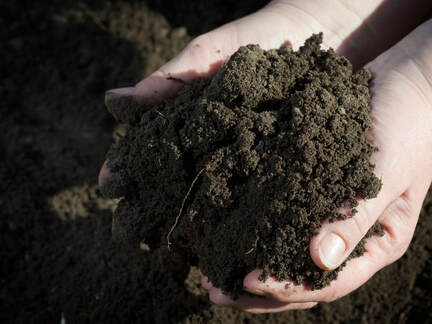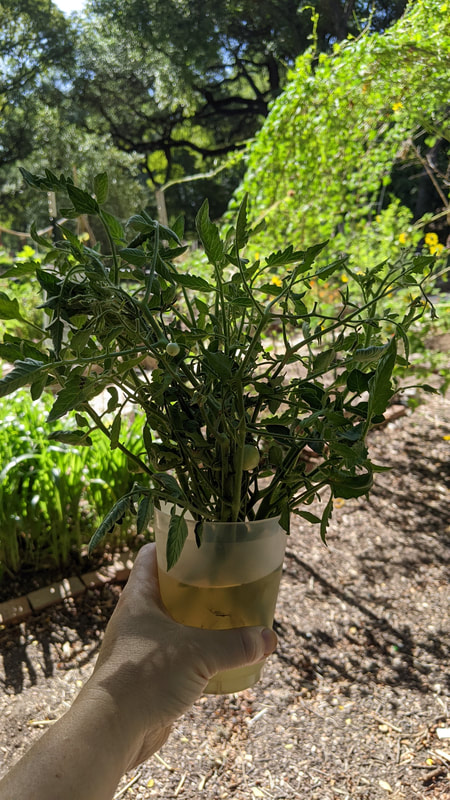|
Have you seen Fantastic Fungi or the movie Avatar? In these films, the research on mycorrhizal fungi by Dr. Suzanne Simard, is brought to life in visually stunning ways. On Monday, September 12th, we welcome three experts to talk about organic fertilizers and amendments. David from Wild Root Organic will share the latest research on mycorrhizal fungi.
Over 95% of all plants across the globe depend on a special type of natural creation called mycorrhizae to pull moisture and nutrients they need from soil. It forms a vital communication network, sometimes called the wood-wide-web, or the “earth’s internet”. This web beneath our feet, connects vast systems of roots from plants and trees all over the planet, like an underground Internet, distributing nutrients and water through this tube-like network. Mycorrhizae facilitates the underground nutrition-gathering process that supports and replenishes the roots of plants to ensure the strongest and healthiest plants possible. Globally, the total length of fungal mycelium in the top ten centimeters of soil is more than 450 quadrillion kilometers! There is a new non profit called SPUN.earth that is using machine learning tools to help map the global network of fungal mycelium. Last month the front page of the International and Domestic NYTimes covered this important work. This fall, the City of Austin will be doing their first mycorrhizal study at the Balcones Canyonland Preserve too. The problem is that most soil doesn’t have enough mycorrhizae. That’s where Wildroot Organic comes in. Wildroot is a proprietary blend of mycorrhizae that helps solve the problem by boosting plant nutrient and water uptake with the added benefit of enhancing the plant’s natural immune system – organically. Come learn about soil amendments with us in a few weeks. Join us in person @zilkerbotanicalgarden or join us online.  We just passed the New Moon phase and are now approaching the First Quarter and are in Waxing Crescent. During the waxing of the moon (the period extending from the day the moon is new to the day it reaches its fullest point), the moon pulls moisture upwards. Seeds do well during this time because moisture is available at the surface of the soil. Fall is a great time for planting veggies in Central Texas and now is the time to get things started if you are planting leafy greens from seed both outdoors and indoors. DIRECT SEED OUTDOORS
SEED INDOORS In Central Texas you can start your brassica seeds indoors in late summer and set them in the garden in autumn for winter harvest. Many of these crops need 120 days to harvest and this gives them a tolerable soil temperature indoors to get a head start. All of these crops can also thrive and do well in frost.
For more ideas on Ornamentals, Perennials, and Herbs, visit the Central Texas Gardener and The Natural Gardener lists online. Download the Texas A&M Extension Planting Chart and Varieties. On Monday, September 12th, we welcome three experts to talk about organic fertilizers. Join us in person @zilkerbotanicalgarden or join us online. Petey from Locoal Biochar @ will be sharing how his company makes biochar from diverted waste materials.
Biochar, also known as Terra preta, is a technique of using charcoal to improve the fertility of soils. It originated in the Amazon basin at least 2500 years ago where the indigenous people of the region create charcoal, mix it with organic matter and broken pottery, and incorporate it in small plots of land from 1 - 80 hectares in size. Terra Preta, as it is known in this area of Brazil, remains highly fertile until today, even with little or no application of fertilizers. And this is in a region of the world known for its highly infertile tropical soils. Terra Preta soils are characterized by high phosphorus content reaching 200-400 mg P/kg, and higher cation exchange capacity, pH and base saturation than surrounding soils. In recent decades, western researchers are just starting to acknowledge the many ways that Indigenous peoples have shaped forest composition and its diversity, and domesticated native plants. In other words, the Amazon didn’t happen on its own or “naturally.” Regions of the world devoid of organic soil carbon have very limited food chains, and little opportunity for the few human inhabitants they can support to develop beyond occupations such as goat herding. Modern agricultural techniques, including tilling and abundant use of chemical fertilizers, pesticides and herbicides, have caused most of the soil organic carbon in developed regions of the world to decompose to CO2. One third of the excess carbon dioxide in the atmosphere is from our soils.  Now is the time to prep and activate your soil for fall, especially with the rain. If you find that water runs off the soil and doesn’t soak in easily, apply a soil activator to help improve soil permeability and feed the living microorganisms in the soil. Add soil activators such as organic compost, molasses, seaweed, bat guano, or organic all purpose like @microlife. There are many options. Our favorite amendment is recycled mushroom blocks. They help with decomposing woody mater in the soil and help with water retention. You can pick them up in 12 locations throughout Central Texas by signing up at CentralTexasMycology.org Join us for our September class Zilker botanical Garden and online to learn the what, when, why, and how of organic fertilizers. We will be joined by experts from @tillerystplantco , @wildrootorganic and @locoal.life! OTHER GARDEN TASKS Cover any bare soil if you haven’t already with mulch or even cardboard. We love sheet mulching and this helps keep down any weeds and the worms love the cardboard. Continue to use seaweed as things are hot and do weekly foliar sprays with liquid seaweed to provide plants with hormones and nutrients needed for heat stress and to prevent disease and pests. Don’t forget to collect deadhead flowering plants. It’s also a good time to start composting because leaves are starting to fall because of the drought. We like to trench compost by digging in between rows and putting our plant matter from the spring/summer season in the pathways with
 🐲 Danielle captured this beautiful widow skimmer dragonfly. They are predators that prey on other insects such as mosquitoes. They catch their prey using their legs and use their fangs to bring prey into their mouth. 🌽 We planted corn directly and squash to get our late summer milpa going. 🍉 The watermelons are still growing and you can tell that they are ready when the closest tendril on the vine is dry and brown. If it is green it needs more time. Some were eaten by wildlife because they are so thirsty. 💦 Be sure to leave water for birds and wildlife so they don't find the water in your juicy vegetables.
🌸 Wow the turmeric is blooming at Zilker this week. Don't miss these beautiful flowers in the Hartman Prehistoric Garden. We also have turmeric growing in the perennial beds thanks to the generous donations from member Steve. We plan to have Steve show us how to plant ginger and turmeric later this year.
🍅 We are still seeing tomato fruits. The sungolds are hanging on and our weekly foliar sprays of seaweed and insecticidal soap seem to be helping. We plan to leave some of the indeterminate varieties but also take cuttings and start new plants. See the Tim's Tomato Tip video to learn how to do this. 🍉 The watermelons are still growing and you can tell that they are ready when the closest tendril on the vine is dry and brown. If it is green it needs more time. 💦 Be sure to leave water for birds and wildlife so they don't find the water in your juicy vegetables. |
AuthorWrite something about yourself. No need to be fancy, just an overview. Archives
May 2024
Categories |





 RSS Feed
RSS Feed